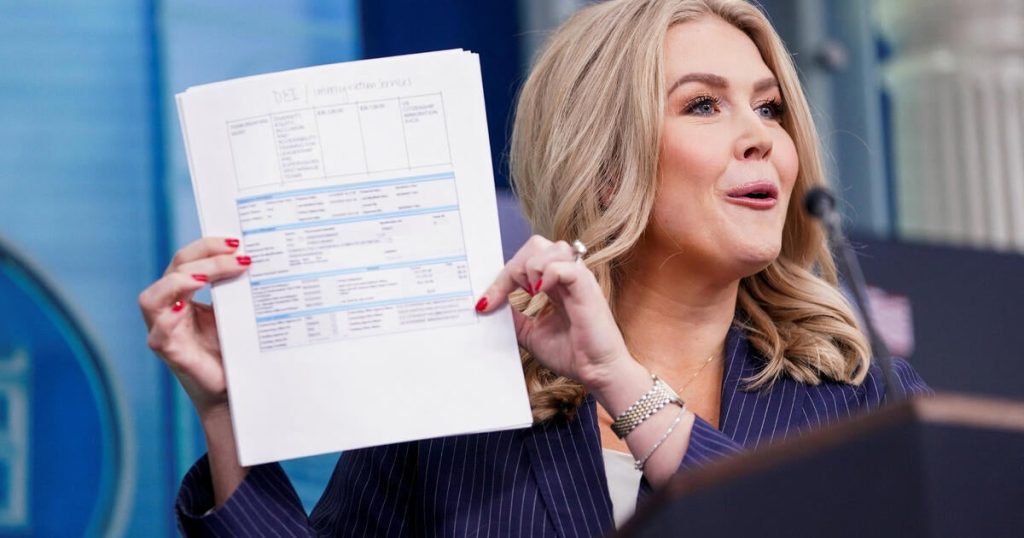The ongoing debate surrounding the government’s financial transparency has intensified following the release of an updated report from the Department of Government Efficiency (DOGE). This report, intended to highlight cost-saving measures through contract terminations and renegotiations, has come under scrutiny due to discrepancies and inaccuracies. With claims of staggering savings dramatically shifting, questions arise about the credibility of the figures presented and the overall implications for the federal budget and workforce.
| Article Subheadings |
|---|
| 1) Discrepancies in Reported Savings |
| 2) Questions Surrounding Contract Listings |
| 3) Broader Implications of Cost-Cutting Measures |
| 4) Responses from Experts and Officials |
| 5) The Future of DOGE and Federal Spending |
Discrepancies in Reported Savings
In a recent release, DOGE reported that the total itemized savings from contract cancellations and adjustments were reduced from $16.6 billion to just $9.6 billion. This startling drop prompts scrutiny as the reported total savings have inflated from $55 billion to $65 billion. Such an increase represents approximately 0.9% of the federal budget for 2024, slated at $6.75 trillion. Officials statewide are left to wonder how such a discrepancy occurred and why documentation supporting these vast claims is largely missing.
DOGE ‘s inability to provide detailed documentation for a significant portion of these claimed savings raises doubts about their accountability. While the agency has attributed its savings to various financial maneuvers including lease terminations, renegotiations, and grant cancellations, the glaring absence of backup data necessitates third-party verification, which remains challenging due to the lack of transparency in the reporting.
Questions Surrounding Contract Listings
An examination of the updated “wall of receipts” listing has unearthed numerous issues, including instances of erroneous data entry, contradictory numbers, and claims of savings that appear inflated or misleading. Initially, DOGE published 1,127 receipts, which have since expanded to 2,299; nevertheless, a significant portion—34%—of these listings record zero savings.
A notable example included a contract for Diversity, Equity, and Inclusion (DEI) training amounting to $25 million. In an apparent miscalculation, DOGE counted each associated company that received funding from this single contract, incorrectly representing it as four separate contracts. As a result, they claimed a savings of $100 million instead of accurately reporting the actual figures.
| Key Points | |
|---|---|
| No. | Key Points |
| 1 | The reported savings were revised down significantly from $16.6 billion to $9.6 billion. |
| 2 | Some entries in DOGE’s reporting include zero savings while others contain potential double-counts. |
| 3 | Contracts involving DEI training were misrepresented, inflating savings significantly. |
| 4 | Key figures showing high savings from contract cancellations may not be verifiable. |
| 5 | Future implications for contractors and federal employees are uncertain as these cuts unfold. |
Broader Implications of Cost-Cutting Measures
The impacts of these flawed calculations go beyond mere bookkeeping; they echo through the ranks of government employees and contractors, many of whom now face job insecurity as a result of the ongoing cost-cutting measures. With contractors now outnumbering federal staff, these moves to zero-out contracts could result in substantial layoffs across multiple sectors.
In light of growing concerns, those involved in government operations are left analyzing how such savings, if credible, would affect service delivery and mission fulfillment. The previous study by the Brookings Institution highlighted the imbalance between federal employees and contractors, with a noted increase in contractor reliance during governance changes. Now, with adjustments to funding and contracts, federal employees and private contractors alike brace for the potential fallout.
Responses from Experts and Officials
Experts have weighed in on the ramifications of the reported discrepancies within DOGE’s financial assessments. Financial analysts and private consultants are expressing concerns over the methodological inaccuracies, impacting the credibility of state efficiency claims. Michael LeJeune, a consultant specializing in government contracts, commented on the misrepresentations saying, “these contracts are formatted in such a way that they rarely yield the savings DOGE is suggesting.”
Additionally, officials have urged for more robust auditing protocols to ensure accountability moving forward. The lack of clarity surrounding reported financial data has fueled calls for legislative action that firms up reporting standards and encourages transparency throughout the governmental budgetary process.
The Future of DOGE and Federal Spending
Looking ahead, the integrity of DOGE’s reporting practices will undoubtedly be under the microscope. As federal expenses elevate and reform initiatives gather pace, questions loom regarding how similar discrepancies might impact future legislative measures aimed at fiscal responsibility. Stakeholders hope for a clearer framework that can reconcile efficiency goals with accountability.
In the wake of increased scrutiny and criticism surrounding current practices, DOGE has a pivotal role in reassessing its strategies to remain transparent without undermining objectives aimed at improving cost-efficiency across government operations.
Summary
The discrepancies in DOGE’s reported savings expose significant challenges in maintaining fiscal accountability within government operations. With inflated claims lacking proper documentation and significant concerns raised by experts, the potential implications cut deep into the fabric of federal employment and contracting. As calls for enhanced transparency intensify, stakeholders must confront the realities of financial stewardship to assure both taxpayers and government employees of responsible practices moving forward.
Frequently Asked Questions
Question: What is DOGE’s role within the government?
DOGE is responsible for enhancing the efficiency of government operations by overseeing cost-cutting measures, contract terminations, and renegotiations.
Question: How have the reported savings changed over time?
Initially reported savings were $16.6 billion but were later revised down to $9.6 billion, while overall claims for savings have increased significantly.
Question: What are the potential impacts of these discrepancies?
The inaccuracies in reported savings could lead to layoffs among contractors and federal employees due to cutbacks, and also raise concerns over the integrity of government financial reporting.


